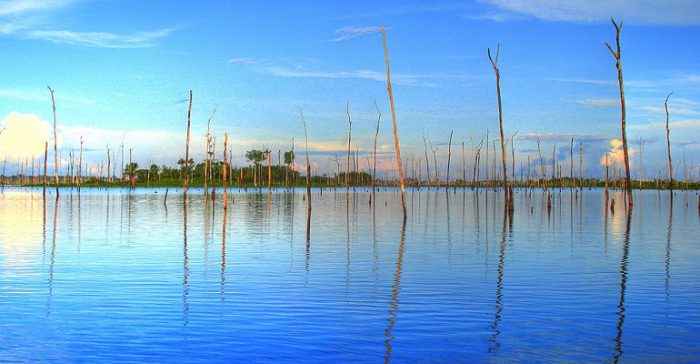Valerie Eacret, ERS, for Zondits
March 21, 2016. Image credit: Seabirds
Almost 30 years ago, Brazil flooded an enormous area in the Amazonian rainforest to generate hydroelectric power in what some called an environmental crime. Today, it only produces 20% of its capacity. The artificial lake is so large that the horizon is barely visible from the dam’s wall. Sunlution and Ciel et Terre are now working on a floating solar panel project that will include 540,000 sq ft of solar panels – about the size of five football fields — that should produce 5 MW of electricity. They hope to increase this to 300 MW by transforming the hydroelectric power generators into “unlimited power producers” by allowing them to use solar energy. This will come in handy especially during periods of drought, which Brazil has been experiencing recently, because the dams produce less energy when water levels are low. The dam is only 125 miles north of the equator, thus the energy generated from the solar panels should be more consistent than that produced from high water levels. Brazil’s Energy and Mining Minister Eduardo Braga recently inaugurated the first floating panels on the lake. He explained that the cost-benefit relationship of the power station can mitigate the cost of the crime. While floating solar panels are not new, the application of combining them with a hydroelectric dam is.
Brazil uses dammed lake surface for floating solar panels
Phys.org, March 13, 2016
Two decades ago, a section of the Amazon rainforest was flooded for a dam that currently produces little electricity. Engineers now see that artificial lake as an ideal surface for floating solar panels.
Brazil gets 60 percent of its electricity from hydroelectric power plants. But much of the country, including in the Amazon rainforest area, has been enduring a severe drought. Water levels at many Brazilian dams have dropped to dangerously low levels.
The Balbina pilot project, to be completed by 2017, is a large platform with 50,000 square meters (540,000 square feet) of solar panels, about the size of five football fields.
The panels can produce five megawatts of electricity, enough to supply some 9,000 homes with power.
Engineers hope to increase the output to 300 megawatts, allowing Balbina to produce electricity for 540,000 homes.
Read More
